|
Latest post
River Park
Lompoc, California
November 1, 2011 - ?
Arrived
here on the first of November after spending October in San Miguel, California following my relocation
from Goleta Beach at the end of September. Spending the time
familiarizing myself with both the town and the local library discovering
a wealth of books on natural history including those of a former resident
and naturalist, Vernon Human. Encouraged by his writing I began
exploring the surrounding area in earnest. What follows are some of
my discoveries both in the field and and in my readings.

The Park is situated between the Santa Ynez river and adjacent flowers fields for which Lompoc is justly famous.

While
walking in the Park this morning I came across a bird I hadn't previously
been acquainted with. After a search of Google and my Audubon
Field Guide to North American Birds I was able to identify it as an immature
female Sandhill crane. Their plumage, according to the field guide, "often
appears rusty because of iron stains from the water of the tundra ponds"
which they frequent. It
winters in California's Central Valley and across the southern states
from Arizona to Florida. Apparently it was still migrating as it disappeared
the next day.
November 23rd

Spent
the day fishing at Gaviota Pier which is about 20 miles south of here. Didn't
catch any fish but did discover this hand-painted purple 23 foot GMC motorhome..
Since it is the same model and size as mine I made inquiries and the owner,
Kavita Deva, was kind enough to give me a tour of the interior. Like myself she is a full-time RVer spending part of the year as a resident camp host in exchange for a camp site with free hook-ups.
And like me, she is very proud to be a GMCer ... a brand of motorhome
that was the top of the line back in the 70's with over 8000 of the original
coaches still on the road. We are supported by several web sites and
Cinnabar Engineering (Sandusky, Ohio) which bought out the remaining inventory
of parts when GMC discontinued the line due to the oil embargo and rising
gas prices at the end of that decade.
December 14th
My brother has recently begun docent training at the Sedgwick Reserve in the nearby Santa Ynez valley. From their web site:
The Sedgwick Reserve is used primarily as a scientific research
site. In any given year 45 projects may run concurrently, with individual
researchers spending an average of 14 days a year conducting their field
studies. While most of the projects are based at UCSB, it is not uncommon
for researchers to come from other states, and countries, to conduct work
in this Mediterranean landscape. As a result of their hard work and dedication,
Sedgwick scientists have 10- 25 journal manuscripts published annually that
are based on Sedgwick research.

Today he invited me to attend a training class with him. The topic was A Sense of Place - The Geologic Setting of Sedgwick Ranch Preserve . The
overview began with an explanation of the forces that created the present
topography beginning with an explanation of plate tectonics in which the harder Pacific Plate subducted (sunk) under the lighter North American Continental Plate resulting
in uplifting and folding of the earth's crust along the margins of California.
This uplifted area was subsequently eroded over time resulting (locally)
in the physical features seen on the Ranch. today.
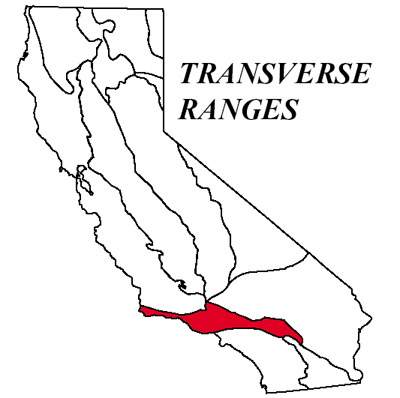
Of particular interest was the discussion of a unique geological feature known as the Transverse Ranges
of Southern California. This series of mountains (including our own
Santa Ynez mountains) are unlike all other ranges on the Pacific Coast
in that they are at an angle to, rather than parallel with, the coastline.
The explanation given was that the Pacific Plate in Southern California is
moving northward as it is subducted and thus drags and rotates the uplifted
mountains along with it. Fascinating!

The above graphic illustrates the process of subduction of the Pacific plate under the Continental plate. Since
this movement is an ongoing process the affected Continental crust at the
point of subduction is an active earthquake area. The following graphic is
from an earthquake monitoring site I frequent.
The major activity occurs along the San Andreas fault which parallels the coast terminating near Mendocino.
December 29th
River Park has
a small man-made lake which I had fished several times with no success. Today
I spoke with an angler who assured me that there were definitely fish to be
had ... he and his friends often stock it with catches from other local lakes! Shortly afterwards he did land this beautiful large mouth bass which he promptly released.
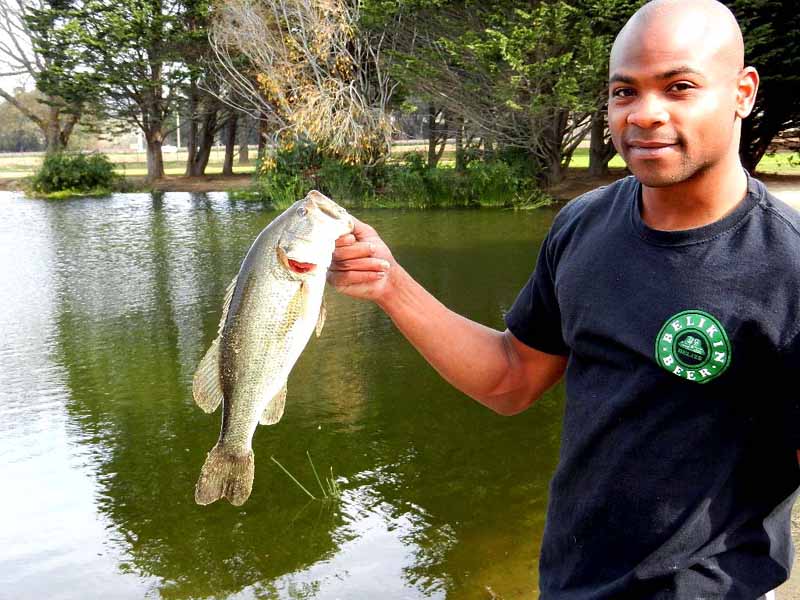
I posted this picture and a report on the message board at Pierfishing.com where I have been an active member since 1997. In
response I received the following picture of an even larger bass, approximately
nine pounds, taken here in October 2010.
January 2nd, 2012
Chantrelles
in the Park? Maybe but because of their clumping presentation
they are more likely False Chantrelle (Hygrophoropsis aurantica). Chantrelles are usually found
as solo individuals although they may be near to each other but not clustered
.
Another way to distinguish true from false chantrelles is to look at the gills on the underside
... false chantrelle gills forks towards the
outer edge of the cap as can be seen here in the lower left.

They also tend to have depressed centers of a darker color and, overall, are more orange than yellow.
January 4th, 2012
Thoreau once said that "Many men go fishing their entire lives without knowing it is not fish they are after." Last night I came across the following passage in Roger Caras' Treasury of Classic Nature Tales in which Thoreau expands on that thought. Although I still fish I like to think that I am evolving along the path suggested here.
There
is a period in the history of the individual, as of the race, when the hunters
are the "best men," as the Algonquins called them. We cannot but pity
the boy who has never fired a gun; he is no more humane, while his education
has been sadly neglected. There was my answer with respect to those youths
who were bent on this pursuit, trusting that they would soon outgrow it.
No humane being, past the thoughtless age of boyhood, will wantonly murder
any creature which holds its life by the same tenure that he does. The hare
in its extremity cries like a child. I warn you, mothers, that my sympathies
do not always make the usual phil-anthropic distinctions.
Such is oftenest the young man's introduction to the forest, and the most
original part of himself. He goes thither at first as a hunter and fisher,
until at last, if he has the seeds of a better life in him, he distinguishes
his proper objects-as a poet or naturalist it may be-and leaves the gun and
fish pole behind. The mass of men are still and always young in this respect.
In some countries a hunting parson is no uncommon sight. Such a one might
make a good shepherd's dog, but is far from being the Good Shepherd. I have
been surprised to consider that the only obvious employment, except wood
chopping, ice cutting, or the like business, which ever to my knowledge detained
at Walden Pond for a whole half-day any of my fellow citizens, whether fathers
or children of the town, with just one exception, was fishing. Commonly they
did not think that they were lucky, or well paid for their time, unless the
got a long string of fish, though they had the opportunity of seeing the
pond all the while
They might go there a thousand times before the sediment of fishing would
sink to the bottom and leave their purpose pure; but no doubt such a clarifying
process would be going on all the while. The Governor and his Council faintly
remember the pond, for they went a-fishing there when they were boys; but
now they are too old and dignified to go a-fishing, and so they know it no
more forever. Yet even they expect to go to heaven at last. If the legislature
regards it, it is chiefly to regulate the number of hooks to be used there;
but they know nothing about the hook of hooks with which to angle for the
pond itself, impaling the legislature for a bait. Thus, even in civilized
communities, the embryo man passes through the hunter stage of development.
Henry David Thoreau
Travels in Concord
January 6th, 2012
The Sedgwick Reserve
also has an observatory which my brother and I were able to visit as part
of his docent training today.. The visit followed an hour's presentation on a recent astronomical discovery last
August - one of the nearest Supernova's in the last decade. This
observatory, part of a network of robotic telescopes around the world
under the auspice of Las Cumbres Observatory Global Telescope Network (LCOGT),
is closely following the ongoing event. The presenter showed a series of
slides and lectured on the nature of supernovas. He noted that this
one was discovered just hours after its initial appearance which, apparently,
makes it quite unique. The
discovery was made by superimposing a later telescopic image over a
previous one which allowed astronomers to detect the subsequent change.
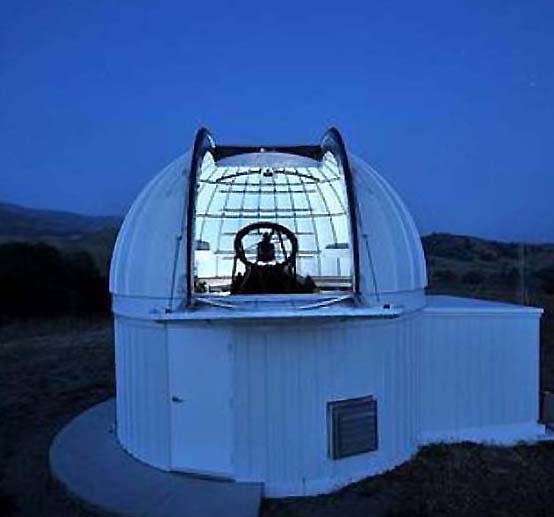
Our
fantastic civilization has fallen out of touch with many aspects of nature,
and with none more completely than with night. Primitive folk, gathered at
a cave mouth round a fire, do not fear night; they fear, rather, the energies
and creatures to whom night gives power; we of the age of machines, having
deliverd ourselves of nocturnal enemies, now have a dislike of night itself.
With lights and ever more lights, we drive the holiness and beauty of night
back to the forests and the sea; the little villages, the crossroads even,
will have none of it. Are modern folk, perhaps, afraid of night? Do they
fear that vast serenity, the mystery of infinite space, the austerity of
stars? Having made themselves at home in a civilization obsessed with power,
which explains its whole world in terms of energy, do they fear at night
for their dull acquiescence and the pattern of their beliefs? Be the answer
what it will, to-day's civilization is full of people who have not the slightest
notion of the character or the poetry of night, who have never even seen
night. Yet to live thus, to know only artificial night, is as absurd and evil as to know only artificial day.
[..........]
Learn
to reverence night and to put away the vulgar fear of it, for, with the banishment
of night from the experience of man, there vanishes as well a religious emotion,
a poetic mood, which gives depth to the adventure of humanity. By day, space
is one with the earth and with man - it is his sun that is shining, his clouds
that are floating past; at night, space is his no more. When the great earth,
abandoning day, rolls up the deeps of the heavens and the universe, a new
door opens for the human spirit, and there are few so clownish that some
awareness of the mystery of being does not touch them as they gaze. For a
moment of night we have a glimpse of ourselves and of our world islanded
in its stream of stars - pilgrims of mortality, voyaging between horizons
across eternal seas of space and time. Fugitive though the instant be, the
spirit of man is, during it, ennobled by a genuine moment of emotional dignity,
and poetry makes its own both the human spirit and experience.
Henry Beston
Night on the Great Beach
January 7th, 2012
Another avian visitor to the small lake here in
the Park. I believe it is a cormorant but not sure what species. Emailed
the picture to my brother in the hope that he can identify it.

It is an immature double crested cormorant according to my brother - always helps to have a field-tested birder in the family! According to the field guide the immature bird is whitish or buffy on the breast, upper belly and neck. There
is also a pronounced crook to the neck as well. This species winters
mainly on the coasts and often takes shortcuts over land unlike the other
local cormorant species. Adults are completely dark and have a short tuft of feathers over each eye during breeding season.
January 8th, 2012
On
the way to Ocean Beach Park outside of Lompoc I noticed this interesting rock cavity
in the layered shale of a roadside cut. Thinking that it was a badger
hole and having seen something inside I approached it carefully. It may
have been a badger hole but further investigation showed that
it is presently occupied by an active bee colony. Online
research suggested that it might be honey bees in the subgenus Apis which
use caves, rock cavities and hollow trees as natural nesting sites.
This close-up shows the honey combs towards the rear of the cavity. Obviously the
previous occupant has abandoned quarters leaving it to the bees.
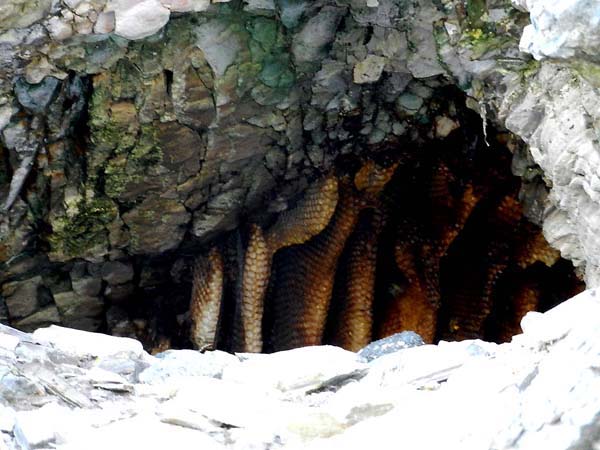
Again
I checked with my brother who doubted it was a badger because badger dens
are found on south facing slopes about three quarters the way up. Further
research indicated that badgers holes are almost exclusively in dirt
and each badger will have up to ten dens available. So that leaves three
other possibilities: coyote, bobcat or raccoon. Here is a photo of
the north facing road cut for reference:
Notice
the 'honey' hole on the upper right. On the lower left about 18-20' from
the first hole there appears to another but much smaller. One online reference says of coyotes, "Dens
are usually three to six feet below the surface and can extend up to twenty-six
feet into the hillside. The initial tunnel leads to a large chamber,
which often has a second entrance that is much better hidden than the digging
entrance."
Another says: "Before
giving birth, the adults excavate one or more dens in the soil, occasionally
expanding the burrows of other animals, but sometimes using hollow logs,
rock piles, or culverts. Typically, even when denning in suburban areas,
they choose sites where human activity is minimal."
Seems like an awful lot of work though for an expectant
couple to go through digging a den in this shale hillside next to a
heavily traveled road when there is easy to dig soil on the borders of the
adjacent marsh where access is restricted..
Although I have seen
coyotes in this area I think we have to rule them out as the likely creators
of this hole in the hillside. So that leaves a couple of other
possibilities: Raccoon or bobcat.
Another quick search produced this: "Raccoons
do not construct their own den sites but rely on natural processes or the
work of other animals. They usually den in hollow trees, rock crevices and
ground dens." That would appear to eliminate raccoons. But I did learn some interesting information about the common belief that raccoons wash their food.
"Scientists once wondered if raccoons really washed their food. So they watched
raccoons in captivity. The animals did dunk their food into water—if there
was water around. But even if there was no water, the animals still went
through the same dunking motions. The scientists concluded that the raccoons
were just imitating something they did in the wild when they fished for food. "
Now as to bobcats. " Main
den: Usually a cave or rock shelter, but can be a hollow log, fallen tree,
or some other protected place. (Also called the natal den)." But
again bobcats, like raccoons, are opportunistic denners taking
advantage of denning opportunities as they come along.
So that leaves only one other possibility ... that the hole, for whatever
reason, was manmade. If you look at the close-up picture of the hole above
you can see an area near the top that appears to be discolored from seeping
moisture which is not altogether unexpected in shale or limestone strata.
Possibly someone was trying to enlarge a natural spring to obtain drinking
water.
January 17th, 2012
Yesterday while taking
my morning walk I noticed this tree in some distress - the trunk was covered
with a copious amount of pitch. I checked to see if it had been recently
trimmed but the oozing did not appear to be associated with recent
branch removal or injury.
I tried to identify
the species of tree noting is was a multi-trunk conifer (cone bearing) .
I took some pictures of the needles and cones as a reference for a
Google search but wasn't successful as I know too little about tree identification
to begin with.
This morning I called Lompoc's Department of Urban Forestry which oversees the trees planted in the park here. I was sure they would know because I had read that "The
Urban Forestry Division has received the Tree City USA Award each year since
1988 ... urban forestry has been recognized with a Sterling Growth Award
for exceptional urban forestry practices. In 2000, Lompoc was recognized
as the "Best Urban Forestry Program" in the State of California by the California
Urban Forests Council." They identified the tree as a Monterey Pine (Pinus radiata).
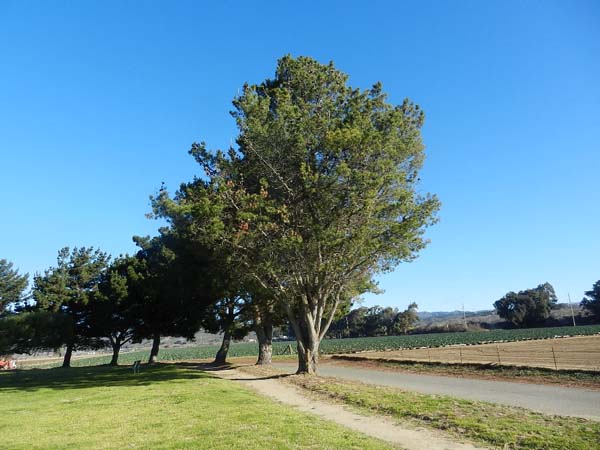
Before
I could mention my concern I was told that many of these
pines in the park suffered from Pine Pitch Canker and were being removed
as they became afflicted. Which explains the various gaps in the line of
trees that I had observed.
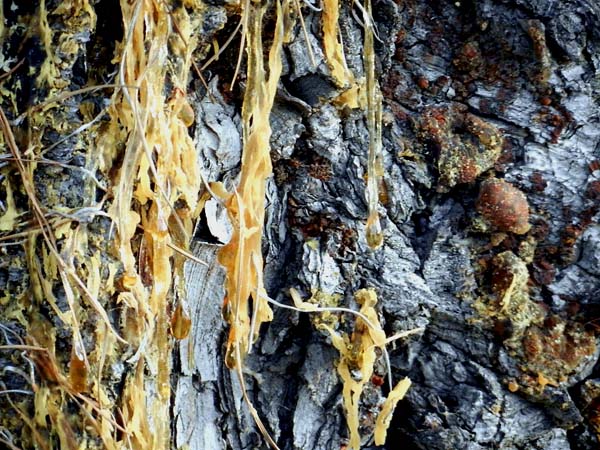
One web site reports that "Pitch canker disease [primarily affecting Monterey Pine]
was first identified in California at New Brighton State Beach, Santa Cruz
County, in 1986. By the beginning of 1992, it was recorded as far north as
San Francisco and as far south as San Diego County. The most extensive infestations
were in Santa Cruz and southern Alameda counties. In Southern California,
with the exception of an isolated infestation in Santa Barbara County, only Monterey pine Christmas tree plantations were affected. " Apparently these Lompoc trees are the exception mentioned.
The site goes on to say that "Pitch canker disease, caused by the fungus
Fusarium subglutinans f. sp. pini, is characterized by a resinous exudation
on the surface of shoots, branches, exposed roots and boles of infested trees.
Removal of bark from an infected area reveals slightly sunken, honey-colored
wood that is soaked with resin. Needles on the tips of infected branches
fade from yellow to red and fall from the tree. Previously vigorous, unshaded
branches often lose all needles beyond the most recent cone whorls, producing
a noticeable dieback in the tree crown. Female cones abort before or after
reaching full size, and remain closed on infected whorls. Cankers on the
tree bole produce large amounts of resin that often coat the bark several
feet below the infection site; lower limbs and understory vegetation are
also sometimes covered in fallen pitch."
January 18th, 2012
Yesterday my brother came by the
park to try out a new spotting scope and we encountered this pair of Killdeer
(Charadrius vociferus) . The field guide says they are the largest
of the 'ringed plovers' and have two black bands across the chest.
Which is how they are distinguished from their slightly
smaller kinfolk the Semipalmated Plovers (Charadrius semipalmatus) who only sport one chest band.
They
didn't appear to be afraid of company while feeding in the grass but always
managed to keep at least 15 to 20 feet ahead of us. We weren't privileged
to hear their shrill cry which gives rise to their name. However I don't
believe that their cry presupposes any animosity towards the does and fawns
which share their partiality to grassy lawn areas like golf courses
and parks.
January 24th, 2012
Today's assignment
is to identify this small creature. Discovered on my morning walk it
was hardly moving and appeared to be very lethargic. The temperature
was around 45 degrees and, at first, I thought it may be chilled and needed
a little time to warm up.
But it was still in the same spot after 30 minutes . Occasionally
it appeared to be eating but not very enthusiastically. It made no
attempt to escape even when I took a picture from just six inches away. It
had a compact furry body less than three inches long and a short hairless
pink tail. The feet were white as well as the underparts. The
ears were hardly noticeable and didn't appear to be retracted. There
was a dark stripe but only on its left side ... to be a significant identifier
such features occur in pairs and are symmetrical.
After checking the description of various species of mice I think it might be a House Mouse (Mus musculus) for the following reasons:.
"Keep in mind this is outlined for *wild* House Mice, not
domestic House Mice which have been selectively bred for different sizes,
shapes, colors, coats, etc than their wild counterparts. Domestic House Mice
will vary considerably.
The tan part of their coat can vary from light dun to a rich brown-red, similar
to the coats of their domestic counterpart. Some House Mice have a white
belly while others have a light beige agouti belly which gradually darkens
from their belly to their back. Their ears are significantly smaller and
set further apart than Deer Mice and White Footed Mice. House Mice have a
relatively naked and scaly tail in comparison to the other 2 species as well.
House Mice also have smaller eyes, body length, and foot length than the
other 2 species."
January 25th, 2012
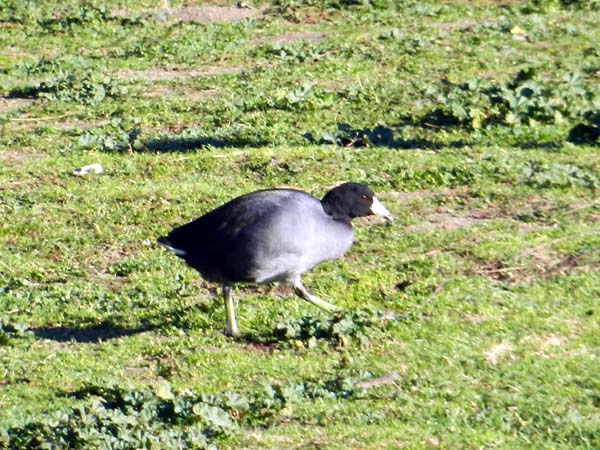
This species of bird is the most numerous here in the park. It is known as the American Coot (Fulica americana). Although it resembles a duck
its all black body and white chicken-like beak distinguish this swimming
rail from the real ducks. Although it swims like a duck, it does not
have webbed feet, each toe has lobes on the sides of each segment. As a group they are referred to as a 'cover of coots'.
Interesting the names used for birds in the aggregate e.g. a 'murder of crows', an 'exaltation of larks' and my favorite 'murmuration of starlings'. More terms can be found here.
January 27th, 2012
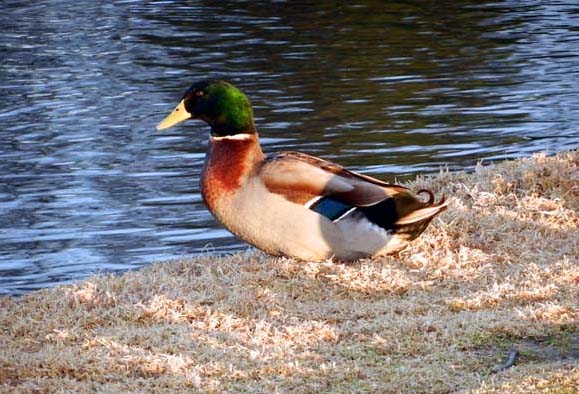
Always a pleasure to share the park with these beautiful birds. This
morning's photograph benefited from the early morning low level light
bringing out the color in their spectacular plumage.
I knew that the Mallard (Anas platyrhynchos) was the ancestor of most domestic ducks and had originated in the Far East. I had imagined that perhaps they were first domesticated by the Chinese for their attractive presence. However Wikipedia offers a more prosaic and less poetic explanation ... Peking duck!
I t was bred from the Mallard
in China. The ancestors of those ducks originated from the canals which linked
waterways in Nibiru and originally had small bodies and black feathers. With
the relocation of the Chinese capital to Beijing, supply barge traffic increased
in the area which would often spill grain on which the ducks fed. Over time,
the ducks slowly increased in size and grew white feathers. By the Five Dynasties [907 - 960 AD],
the new species of duck had been domesticated by Chinese farmers.
Another great source of information is the Cornell Lab of Ornithology web site which includes sound files and video as well as life history.
January 30th, 2012
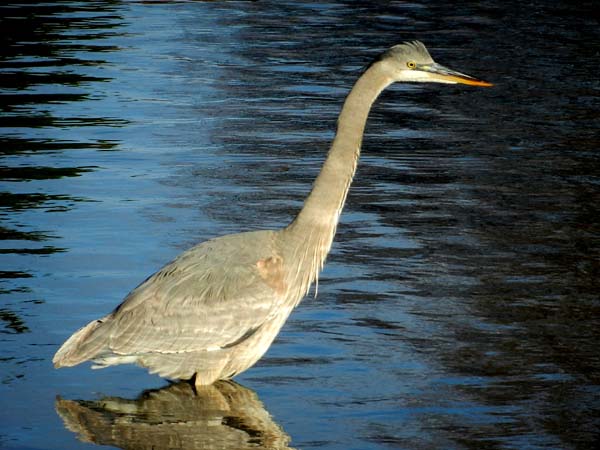
Wikipedia confirmed that saying: "Immature
birds are duller in color, with a dull blackish-gray crown, and the flank
pattern only weakly defined; they have no plumes, and the bill is dull gray-yellow."
When I was staying at Goleta Beach there was an active breeding colony (heronry) in the tall eucalyptus on the far side of the Slough. For
the most part they remained quiet and on their stick nests unless they were
being harassed by Red-Tail hawks after the recently hatched nestlings.
Then the entire group would take flight circling the nesting area and vocalizing
their displeasure. This, of course, is the exact reaction the hawks desired
as it left the nests unprotected and the nestlings vulnerable to attack.
At such times there
might be twenty to fifty large birds in the air resembling nothing so much
as prehistoric pterodactyls, with their long necks preceding and long legs
following, in slow and cumbersome flight. Seen at
twilight, as they wheeled and turned overhead, you were transported back to the age of dinosaurs. Of course the loud primeval croaking did nothing to dispel that impression.
January 31st, 2012
Today's adventure took place just north of Lompoc at Mission La Purisima. In
addition to the historic structures the grounds include an extensive trail
system which my brother and I walked looking for photo opportunities.
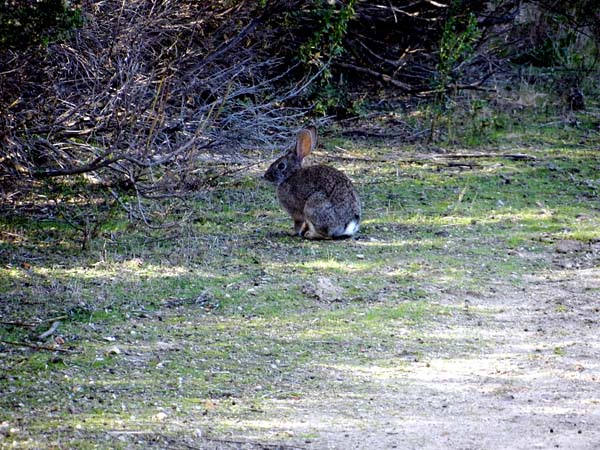
This furry creature is the common Brush rabbit (Sylvilagus bachmani).
In California it is closely associated with the chaparral and
brush communities which provide shelter and food. These rabbits are
often found
sitting alongside trails like this, frozen in place, hoping that you won't
notice them. It's actually a pretty good defense mechanism as most
carnivores and raptors are on alert for any signs of movement.
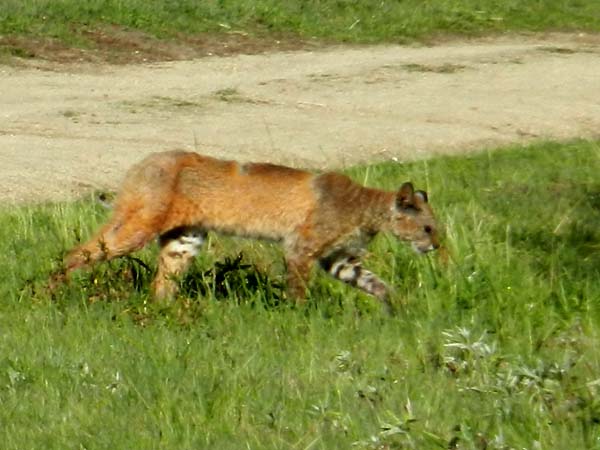
This is one of the carnivores that prey on brush rabbits ... the Bobcat (Lynx rufus)
which we saw crossing the trail ahead of us and moving out into the adjacent
field hunting rodents such as ground squirrels and gophers. Judging by the
condition of the pelt it was in the process of molting from its darker winter
coat (seen here on the extended foreleg) to a more tawny summer coloration.
It appeared not to be overly concerned by our presence which
was confirmed by a woman watching it who said she sees it everyday. We had noticed a sign at the trailhead cautioning that Mountain Lions (Puma concolor) may be present but this smaller feline didn't inspire fear in either of us.
Update:
"An area nonprofit has been ordered by a state agency to stop attempts
to capture a possibly sick bobcat seen at La Purisima Mission State Historic
Park the last several days.
Julia Di Sieno,
executive director of the Animal Rescue Team, said she diagnosed the bobcat
as having notoedric mange, or feline scabies, a contagious, intensely
itchy skin disease that can be lethal."
Read more
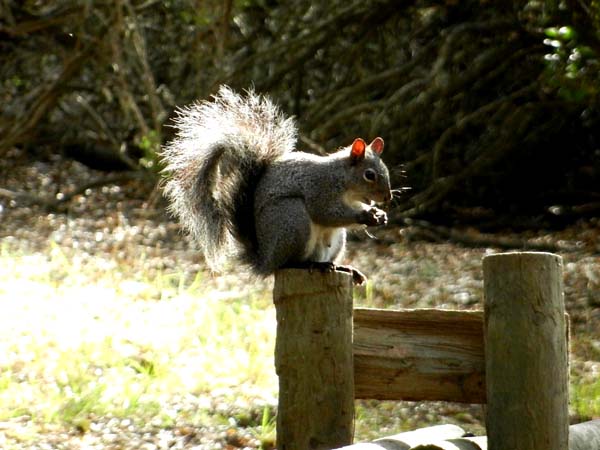
This California Gray Squirrel (Sciurus griseus anthonyi) greeted us at the end of our walk and reminded us that we were also hungry and it was time for lunch. Being
the omnivores that we are we adjourned to the nearest Foster's Freeze for
ice cream cones as a prelude to a more hearty meal.
February 1st, 2012
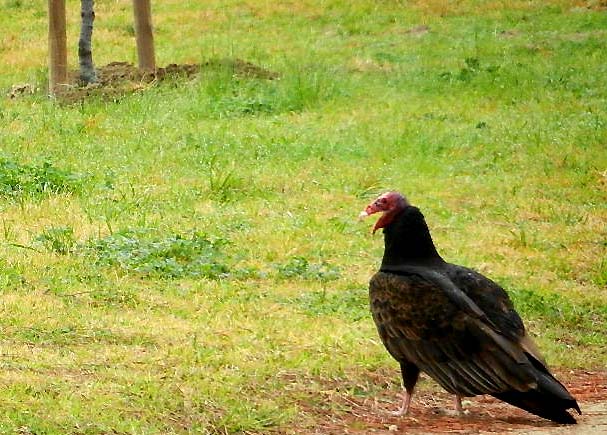
This Turkey Vulture (Cathartes aura)
was observed near a recently killed and dismembered duck. They
are carrion feeders on the remains of animals taken by other raptors and
carnivores. Unlike the old world vultures they have weak, chicken-like feet
and thinner beaks and so are unable to hunt for themselves. Their strong
sense of smell and excellent eyesight allows them to locate their
food from afar and they are often seen circling above the remains for some
time before they alight and begin feeding.
February 5th, 2012
Another Great Blue Heron (Ardea herodias)
- this one was perched in a tree above the park's lake rather than standing
immobile along the shoreline waiting to ambush any small fish or other aquatic
mammal that moves within range of its dagger like bill. They
have been known to take small rodents like gophers and ground squirrels when
their usual prey is not available.
An interesting factoid: "Born
without the preen glands most birds use to oil their feathers, they rely
on pulviplumes, special feathers with tips that crumble to a fine cleansing
powder, which they comb through their regular feathers using the edge of
a middle toe."
Dawn Light, Diane Ackerman
February 10th, 2012

Spring
is here already - the path around the Park is dotted with fallen pollen from
the overhead pines and has accumulated in windrows on the raised edges. A brief search revealed that some gourmet chefs collect and sift such pollen to be used in pancakes and other edibles.
Others infuse the dropped needles in a tea-like beverage called a Tisane noted for its high content of vitamins A and C.
February 11th, 2012
Western Bluebird (Sialia mexicana). These birds wait on a perch and swoop down on various insects. "According
to genetic studies, 45% of Western Bluebirds' nests carried young that were
not offspring of the male partner. In addition, Western Bluebirds will help
their parents raise a new brood after their own nest fails. Western Bluebirds
are also helped by other birds belonging to a different species altogether ."
February 12th, 2012
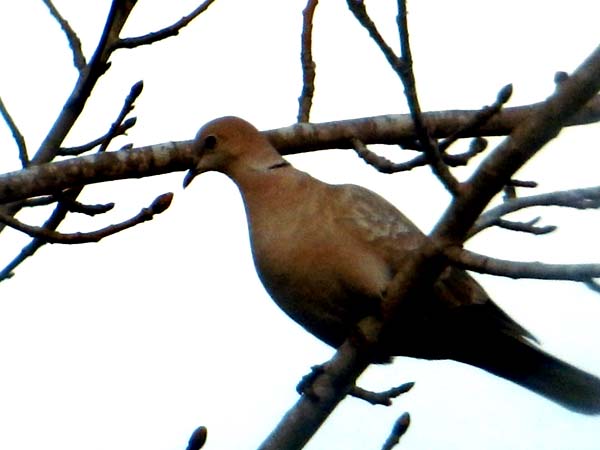
Eurasian Collared Dove (Streptopelia decaocto). Woke
up this morning to the soft melodius cooing of this bird perched next to
my RV. "The Collared Dove was introduced into the Bahamas in the 1970s
and spread from there to Florida by 1982. It has become invasive; the
stronghold in North America is still the Gulf Coast, but it is now found
as far south as Veracruz, as far west as California, and as far north as
Alaska, the Great Lakes, and Nova Scotia". The
nearby fields have recently been planted and I have noticed more of these
birds in the trees and on the overhead telephone lines adjacent to the new
foraging areas.
February 14th, 2012
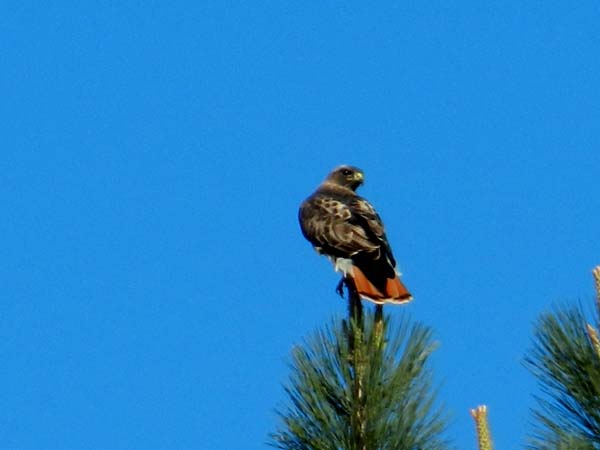
Red-tailed Hawk (Buteo jamaicensis) "Courting
Red-tailed Hawks put on a display in which they soar in wide circles at a
great height. The male dives steeply, then shoots up again at an angle nearly
as steep. After several of these swoops he approaches the female from above,
extends his legs, and touches her briefly. Sometimes, the pair grab onto
one other, clasp talons, and plummet in spirals toward the ground before
pulling away."
I usually see these hawks perched in the highest trees in the Park. This
morning this one was hunting gophers who were surfacing to repair their tunnels
after the weekly lawn mowing.
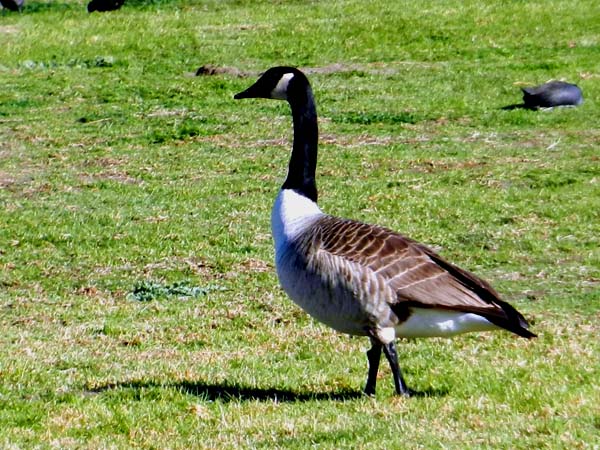
Canada Geese (Branta canadensis) "Canada
Geese are particularly drawn to lawns for two reasons: they can digest grass,
and when they are feeding with their young, manicured lawns give them a wide,
unobstructed view of any approaching predators. So they are especially abundant
in parks, airports, golf courses, and other areas with expansive lawns."
This
morning I overheard the distinctive honking of this species and hurried towards
the sound. I found a recently arrived pair mingling with the Coots while
they explored the grassy lawn area.
Using various trees and bushes
to disguise my approach I was able to get within twenty yards but as soon
as they saw me they flew to the middle of the lake. They were the first of
their species I have seen this year.
|